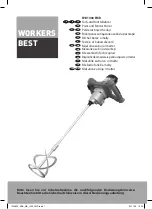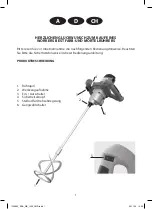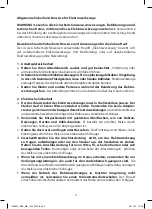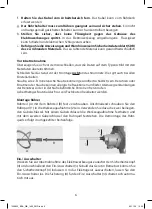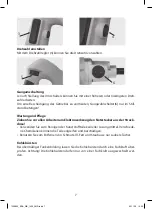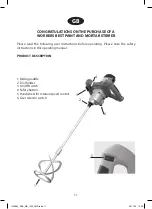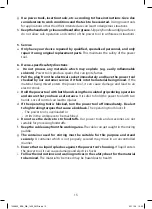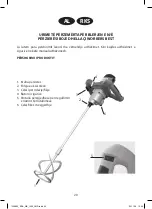
b. Always wear personal protective equipment and safety goggles. The
use of personal protective equipment, such as a dust mask, non-slip safety shoes,
hardhat, or hearing protection, depending on the nature and use of the power tool,
reduces the risk of injuries.
c. Avoid unintentional start-up. Make sure that the power tool is switched off
before connecting it to the mains and/or a battery, picking it up or carrying it.
Having your finger on the switch while carrying the power tool or having the power
tool switched on when you connect it to the power supply can lead to accidents.
d. Remove adjusting tools or wrenches before switching the power tool on. A tool
or a wrench left in a rotating part of the power tool can lead to injuries.
e. Avoid awkward body postures. Ensure that you are standing in a stable and
safe position and maintain your balance at all times. This will enable you to better
control the power tool in unexpected situations.
f. Wear suitable clothing. Do not wear loose clothing or jewellery. Keep hair,
clothes, and gloves away from moving parts. Loose clothing, jewellery, or long hair
could get caught in moving parts.
g. If dust extraction and collection devices can be mounted, ensure that such
devices are connected and used properly. Using a dust extractor can reduce
hazards caused by dust.
h. Do not lull yourself into a false sense of security and do not ignore the safety
rules for handling power tools, even if you are familiar with the power tool
after many uses. Careless action can lead to serious injuries within fractions of a
second.
4. Use and treatment of the power tool
a. Do not overload the power tool. Use the power tool that is designed for your
work. With the suitable power tool you will work better and with more safety in the
specified performance range.
b. Do not use any power tool with a defective switch. A power tool that can no longer
be switched on or off is dangerous and must be repaired.
c. Pull the plug out of the socket and/or pull out any removable batteries before
making device settings, changing insertion tool parts, or putting the power
tool away. This precautionary measure prevents the device from starting up
unintentionally.
d. When they are not in use, store power tools out of the reach of children. Persons
who are unfamiliar with the power tool or who have not read these instructions
must never be allowed to use it. Power tools are dangerous when used by
inexperienced persons.
e. Maintain power tools and insertion tools with care. Ensure that moving parts
of the power tool function properly and do not jam and check whether parts
are broken or are damaged in such a way that the device function is impaired.
Have the damaged parts repaired before using the power tool. Many accidents
are caused by poorly maintained power tools.
f. Keep cutting tools sharp and clean. Carefully maintained cutting tools with sharp
cutting edges jam less often and are easier to control.
14
1223852_BDA_WB_1400_FMR.indd 14
1223852_BDA_WB_1400_FMR.indd 14
02.11.20 12:50
02.11.20 12:50

